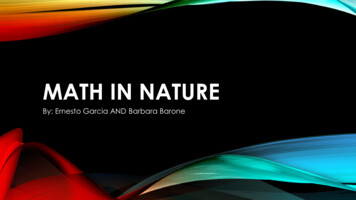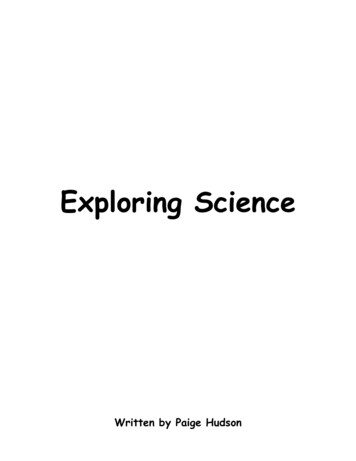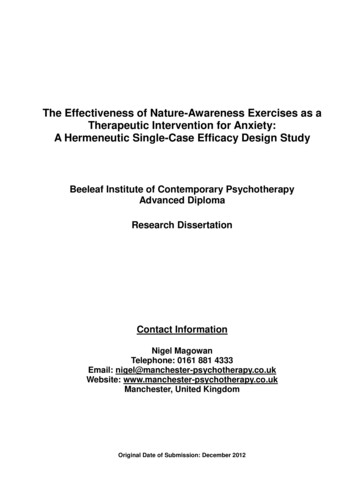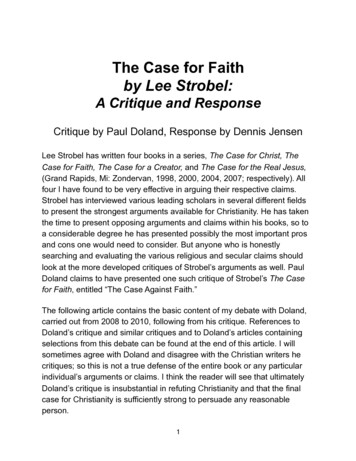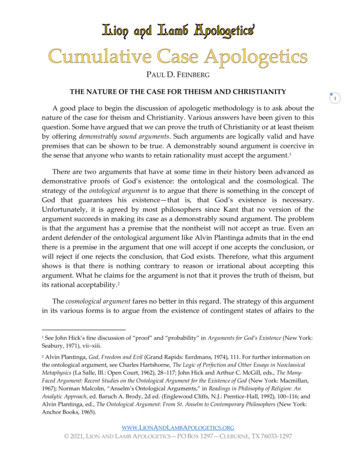
Transcription
PAUL D. FEINBERGTHE NATURE OF THE CASE FOR THEISM AND CHRISTIANITY1A good place to begin the discussion of apologetic methodology is to ask about thenature of the case for theism and Christianity. Various answers have been given to thisquestion. Some have argued that we can prove the truth of Christianity or at least theismby offering demonstrably sound arguments. Such arguments are logically valid and havepremises that can be shown to be true. A demonstrably sound argument is coercive inthe sense that anyone who wants to retain rationality must accept the argument.1There are two arguments that have at some time in their history been advanced asdemonstrative proofs of God’s existence: the ontological and the cosmological. Thestrategy of the ontological argument is to argue that there is something in the concept ofGod that guarantees his existence—that is, that God’s existence is necessary.Unfortunately, it is agreed by most philosophers since Kant that no version of theargument succeeds in making its case as a demonstrably sound argument. The problemis that the argument has a premise that the nontheist will not accept as true. Even anardent defender of the ontological argument like Alvin Plantinga admits that in the endthere is a premise in the argument that one will accept if one accepts the conclusion, orwill reject if one rejects the conclusion, that God exists. Therefore, what this argumentshows is that there is nothing contrary to reason or irrational about accepting thisargument. What he claims for the argument is not that it proves the truth of theism, butits rational acceptability.2The cosmological argument fares no better in this regard. The strategy of this argumentin its various forms is to argue from the existence of contingent states of affairs to theSee John Hick’s fine discussion of “proof” and “probability” in Arguments for God’s Existence (New York:Seabury, 1971), vii–xiii.1Alvin Plantinga, God, Freedom and Evil (Grand Rapids: Eerdmans, 1974), 111. For further information onthe ontological argument, see Charles Hartshorne, The Logic of Perfection and Other Essays in NeoclassicalMetaphysics (La Salle, Ill.: Open Court, 1962), 28–117; John Hick and Arthur C. McGill, eds., The ManyFaced Argument: Recent Studies on the Ontological Argument for the Existence of God (New York: Macmillan,1967); Norman Malcolm, “Anselm’s Ontological Arguments,” in Readings in Philosophy of Religion: AnAnalytic Approach, ed. Baruch A. Brody, 2d ed. (Englewood Cliffs, N.J.: Prentice-Hall, 1992), 100–116; andAlvin Plantinga, ed., The Ontological Argument: From St. Anselm to Contemporary Philosophers (New York:Anchor Books, 1965).2WWW.LIONANDLAMBAPOLOGETICS.ORG 2021, LION AND LAMB APOLOGETICS—PO BOX 1297—CLEBURNE, TX 76033-1297
existence of God as the only explanation for these states of affairs. A familiar form of thisargument is the causal form. We have all heard of it in its simplest formulation. Ifsomething exists, it must have an adequate cause or explanation. The causal chain musteither be infinite or there must be an uncaused cause, God. An infinite regress of causesis impossible. Therefore, God must exist as the uncaused cause of what exists.Many theists, myself included, think that this and other forms of the cosmologicalargument are sound. Again, the difficulty is with those who are not theists. They refuseto accept one of the essential premises to this argument. They might deny that God is theonly adequate explanation for the existence of anything. Or they might argue that aninfinite regress of contingent causes is not impossible. I think the theist is right, but weare trying to convince the atheist, and that is the problem. Thus, if what I have said is thecase, then the cosmological argument does not constitute a proof in the sense of being ademonstrably sound argument.3A second way to understand the case for theism and Christianity is to argue that wecan make a probable case. We will relax the standard and give up the search for absolutecertainty. While we cannot prove that God exists and that Christianity is true, we can atleast show that it is probable, maybe even very probable. There are a variety of ways toattempt this. One of the most common is through the teleological or design argument. Theargument claims that the universe exhibits design or order. According to the theist, thisorder or design is best explained as the work of an intelligent designer.While this argument holds a grip on theists, it is less persuasive for nontheists. Whatpersuades many atheists to reject this argument is that there is an entirely acceptable (andperhaps equally probable) alternative explanation for any order that we find in thisuniverse, namely, evolutionary forces. If one accepts the evolutionary theory, then anyuniverse that survived would have to exhibit order or it would have perished. Thedynamic interactions between organisms and their environment along with the need toadapt for survival are adequate explanations for any order shown by this universe.4For an overview of the statement, defense, and objections to this argument, see Brody, 121–57; Donald R.Burrill, The Cosmological Arguments: A Spectrum of Opinion (New York: Anchor Books, 1967); WilliamCraig, The Cosmological Argument from Plato to Leibnitz (New York: Barnes & Noble, 1979); idem, TheExistence of God and the Beginning of the Universe (San Bernardino, Calif.: Here’s Life, 1979); and idem, TheKalam Cosmological Argument (New York: Barnes & Noble, 1979).3Again, the argument from design can be set out and defended in very sophisticated ways. It is subject toa variety of objections as well. For a survey of the aforementioned, see Brody, 158–212; W. Salmon,“Religion and Science: A New Look at Hume’s Dialogue,” Philosophical Studies 33 (Fall 1978): 143–76; G.Schlesinger, “Theism and Confirmation, Pacific Philosophical Quarterly 64 (January 1983): 46–56.4WWW.LIONANDLAMBAPOLOGETICS.ORG 2021, LION AND LAMB APOLOGETICS—PO BOX 1297—CLEBURNE, TX 76033-12972
Let me summarize the case up to this point. First, traditional arguments that havebeen thought to prove God’s existence and provide a basis for arguing to the truth ofChristianity fail if we understand “prove” in some strict sense that might require theatheist to believe that there is a God. That is, there are some premises in the argumentthat the nontheist will refuse to accept, causing the argument to fail. Second, if weunderstand probability in any meaningful sense, we run into problems as well. Not onlyis the standard relaxed, but alternative explanations can be offered to that of the theist. Ifwhat we have argued is true, it seems that theists can take one of two approaches. Theycan appeal to some form of fideism—that is, they can claim that God’s existence and thetruth of Christianity are matters that are justified by faith alone. Or they can defend thepossibility of a rational case for theism and Christianity of a sort other than those justexamined. The latter approach is not one that conforms to the normal patterns found indeductive or inductive argumentation.5In my judgment, the latter course has more promise. There is a rational approach thathas been called a variety of names, the cumulative case approach or the inference to the bestexplanation approach being the most common. Such an argument is rational but does nottake the form of a proof or argument for probability in any strict sense of these words.This approach understands Christian theism, other theistic religions, and atheism assystems of belief. Such systems are rationally supported by a variety of considerations ordata. The model for defending Christianity is not to be found in the domain of philosophyor logic, but law, history, and literature. This does not mean that the apologist may ignorethe deliverances of philosophy or logic, but that the nature of the case for Christianity isto be found in a different field.The cumulative case approach to apologetics has been adopted by a number ofdistinguished apologists, such as F. R. Tennant, Elton Trueblood, G. K. Chesterton, andC. S. Lewis. It also has been adopted by such philosophers as Basil Mitchell, RichardSwinburne, and William Abraham.6Because the term cumulative case is used in apologetics in ways other than the way Iam using it, it will be helpful to try to explain my use in precise terms.5See Basil Mitchell, The Justification of Religious Belief (New York: Seabury, 1973), 34–39.See, e.g., ibid.; Richard Swinburne, The Existence of God, 2d ed. (New York: Oxford University Press,1991); William J. Abraham, An Introduction to the Philosophy of Religion (Englewood Cliffs, N.J.: PrenticeHall, 1985); and idem, “Cumulative Case Arguments for Christian Theism,” in The Rationality of ReligiousBelief: Essays in Honour of Basil Mitchell, ed. William J. Abraham and Steven W. Holtzer (Oxford UniversityPress, 1987).6WWW.LIONANDLAMBAPOLOGETICS.ORG 2021, LION AND LAMB APOLOGETICS—PO BOX 1297—CLEBURNE, TX 76033-12973
First, the argument for theism and Christianity is an informal one, not a formal one.There are neither premises nor derivations. It is more like the brief that a lawyer brings,or an explanation that a historian proposes, or an interpretation in literature.Second, it is a broadly based argument that is drawn from a number of elements inour experience, which in turn either require explanation or point beyond themselves.Later in the chapter I will set out what constitutes the elements for this case.Third, none of the elements that constitute this case has any priority over any other.In the classical approach to apologetics, priority is given to the proof that God exists. Forthis reason, natural theology and its arguments usually have priority. Once it has beenshown that God exists, his nature and love for the sinner are defended. Such an argumentis cumulative in the sense that Christianity is defended in terms of more than a singleargument. It is not, however, cumulative in the sense that I am using the term because,in the classical approach, God’s existence must be proven first. In the approach I amdefending, one may start with any element of the case, and depending on the response,appeal may be made to some other element to support or reinforce the claim thatChristianity is true.Traditional Christian theists are urging that their explanation makes better sense ofall the evidence available than does any other alternative worldview on offer, whetherthat alternative is some other theistic view or atheism. The opponent is contesting thatclaim. The dispute is over what Gilbert Ryle calls the “plausibility of theories.” 7 WhatChristian apologists are defending is the claim that Christian theism is the bestexplanation of all available evidence on offer. The opponents are required to present amore convincing cumulative case.Fourth, unlike some approaches, the cumulative case approach is not simply a defenseof God’s existence or theism, it is an apologetic for Christianity. Put a bit differently, ifsuccessful, it establishes the Christian worldview, not just a theistic worldview.Basil Mitchell gives a parable of two explorers to explain the nature of a cumulativecase argument.8 They come to a hole in the ground. One explorer finds nothing unusualabout it, while the other thinks there is something odd about it. They find some otherholes in the vicinity. Then they come upon a papyrus fragment in a cave that looks as ifit might be a part of the plan for a building. The large hole could be for the center post,and the other holes for poles that gave support to the sides of the building. They even tryGilbert Ryle, “Induction and Hypothesis,” in Proceedings of the Aristotelian Society, supplementaryvolume (1937).78Mitchell, Justification of Religious Belief, 43–44.WWW.LIONANDLAMBAPOLOGETICS.ORG 2021, LION AND LAMB APOLOGETICS—PO BOX 1297—CLEBURNE, TX 76033-12974
to reconstruct the building. One explorer thinks that he can see how a building once saton that spot. He theorizes that there is some order or plan in the location of the holes.Though he lacks the complete plan, he thinks that the fragment supports his view. Theother explorer, by contrast, sees the placing of the holes as accidental and argues thatthere are unexplained and missing elements in the data. The first explorer, in turn, thinksit is possible to explain why certain elements are missing.Mitchell holds this parable to be a good example of a cumulative case. There is a needfor ultimate and overarching explanations, but attempts to give such explanations mayconflict. The data at certain points may even be capable of a number of differentinterpretations. However, the theory that best accounts for the data is to be preferred.Mitchell tries to relate the parable to the question of God’s existence and the truth ofChristianity. He suggests that the large hole could be the need to explain certain aspectsof the universe and reality, which natural theology is an attempt to address. Some of thesmaller holes represent religious experiences, the experience of God’s presence, of sin,and of grace. Finally, the fragment of the plan is analogous to the concept of the Bible orChristian revelation. In this example, it is even possible to see how the various elementshelp to reinforce one another.Two other examples are offered by Mitchell, one from literature and the other fromhistory. In both disciplines scholars develop theories or hypotheses to explain the text inthe first case and the facts in the second. These theories or hypotheses are themselvestested for their ability to explain the data.9TESTS FOR TRUTHTo settle conflicting truth claims and determine what is the best explanation for all thedata, there must be some tests for truth. The reason for this is simple: Christianity is notthe only worldview that claims to be true.10 Therefore, in this section I will outline what Itake to be the appropriate criteria for testing worldviews.9Ibid., 45–57.For another discussion of similar tests for truth, see Ronald H. Nash, Worldviews in Conflict: ChoosingChristianity in a World of Ideas (Grand Rapids: Zondervan, 1992). While Nash’s approach to apologeticswould be different from mine, it is noteworthy that the tests for truth that he suggests are quite similar tomine. This is because these tests are used generally, and they are not tailored for the religious issue alone.10WWW.LIONANDLAMBAPOLOGETICS.ORG 2021, LION AND LAMB APOLOGETICS—PO BOX 1297—CLEBURNE, TX 76033-12975
The Test of ConsistencyThe first test that any truth claim must pass is that of consistency. This means that asystem of belief must not lead to a contradiction. Any system of belief that is internallyinconsistent is false. To show that a contradiction can be generated from a group of beliefsis the strongest type of disproof. It is called a reductio ad absurdum. Consistency is such astrong test that logicians teach that anything whatsoever follows from a contradiction. Itis fair to say that most systems of belief can be stated in sufficiently sophisticated waysthat they will avoid such a failure. Take this example from the Bible. One might arguethat James says that works alone can save, while Paul teaches that faith alone saves. Isthis not clearly a contradiction, and should not the Christian revelation fail the test ofconsistency? Christian theologians and apologists have thought not. They have claimedthat James and Paul are harmonizable. Paul must be understood as teaching that the basisof salvation is faith alone. James, on the other hand, deals with the evidence for savingfaith. He says that works are the evidence that one has saving faith. Thus, the evaluationof this test when applied to a system of belief will not always be agreed upon. This doesnot detract from the fact that consistency is an exceedingly important test.The Test of CorrespondenceThe second test for truth is correspondence or empirical fit. This test requires that anybelief must correspond with reality. It is related to the belief that a correspondence theoryof truth is the correct theory of truth. Empirical fit is a test between a system of belief andreality. Whenever some belief does not correspond to our understanding of reality, somemay continue to believe it, but since it is hard to avoid the conclusion that that belief isfalse, it will usually not attract many followers. For example, some religious systems ofbelief have taught that sickness and death are not real, but illusions. The faithful maycontinue to believe that this is true, but, as has been said, it is hard not to think that thatbelief is false and that few will accept it.The Test of ComprehensivenessComprehensiveness is the third test for truth. This criterion requires that we prefertheories or systems of belief that explain more of the evidence over those that mightaccount for less. Explanations for the existence of evil in the world are good examples ofthis point. An atheist may claim that evil is best explained by the fact that there is no God,or at least not one with the attributes taught in the Bible. If this was the only datumreligious belief had to explain, the atheist’s conclusion might be best. However, there ismuch more that calls for explanation, and atheism fails this test when compared withChristian theism.WWW.LIONANDLAMBAPOLOGETICS.ORG 2021, LION AND LAMB APOLOGETICS—PO BOX 1297—CLEBURNE, TX 76033-12976
The Test of SimplicityA fourth test for truth is simplicity. This test instructs us not to multiply explanatoryitems unnecessarily. It has also been called Ockham’s razor. If an explanation is bothsimple and adequate, it is to be preferred. The application of this test is not always easyto determine, for when is an explanation adequate? However, there certainly are caseswhere it is clear that elements of explanations are not needed and should not be used.The Test of LivabilityThe next two tests for truth might be called the “pragmatic criteria.”11 The fifth test islivability. It says that for a belief to be true, it must be livable. This is not the same as oursecond test for truth, correspondence. That test is more theoretical, while livability ispractical. For example, some belief or system of beliefs may pass the theoretical test butshow itself to be false, because the advocate of that system constantly contradicts hissystem in living out his life.The Test of FruitfulnessThe sixth test for truth is fruitfulness. Here we ask what the consequences are ofholding such a view of reality. Does it produce fruitful consequences? Take two systemsof belief, one that holds that reality is totally disorganized and random, while the otherholds that reality is characterized by regularities. On this criterion the latter theory willbe preferred, as it will make things like science possible.The Test of ConservationFinally, I suggest conservation as a test for truth. By this I mean that when we find someanomaly to our theory, we first choose solutions that require the least radical revision ofour view of the world. Put another way, we seek to modify the paradigm that we areusing to understand reality rather than immediately making a radical shift to a new one.For many years Newtonian mechanics constituted the reigning paradigm. Anomaliesarose to this system of belief. What occurred first were attempts to modify Newton’sviews. At some point the problems became so great that it was decided that a newparadigm was needed, and a major shift took place. This is what conservation requires.It is based in the belief that any system of belief that has reached the position of a reigningparadigm must have a good deal of evidence supporting it. Therefore, it is not wise toabandon it as a first move.11Ibid., 62–63. Nash calls these the test of practice.WWW.LIONANDLAMBAPOLOGETICS.ORG 2021, LION AND LAMB APOLOGETICS—PO BOX 1297—CLEBURNE, TX 76033-12977
Before I conclude this discussion, a few observations are in order. First, it should beclear that these tests for truth are tests that would be used throughout rational discourse.There is no special pleading by theists for tests that will give their views an advantage.These are tests that scientists, historians, and others—not just theists—would use insettling conflicting truth claims.Second, not all of these tests or criteria are of equal importance. Undoubtedly, themost important test is the first, consistency. As I said, if a system of belief cannot pass thistest, then it may be dismissed. Correspondence or empirical fit is next, andcomprehensiveness follows that.Third, once one gets to the criteria that follow comprehensiveness, the order ofimportance becomes less clear. In some case, livability might be more important thansimplicity, and in another not.Fourth, the evaluation of any system of belief in terms of these criteria will be open todebate. This is not because truth is relative, but because our knowledge of any system ofbelief is fallible. This explains why it is that two individuals looking at the same evidencemay come to different conclusions. Further, this shows the importance of the internalwitness of the Holy Spirit in the defense of Christian theism.THE ELEMENTS OF THE CUMULATIVE CASE FOR CHRISTIANITYI have spoken about elements of our common human experience that requireexplanation and that point beyond themselves to something more in a general way. Inwhat follows I will attempt to describe the most important elements that make up thecumulative case for Christianity. The name I shall give to the case for Christianity is “thewitness of the Holy Spirit.” I take this name to emphasize the importance that allChristians place on the work of the Holy Spirit in the defense of the faith. The Scripturesteach that God, through the person of the Holy Spirit, witnesses to the truth ofChristianity.WWW.LIONANDLAMBAPOLOGETICS.ORG 2021, LION AND LAMB APOLOGETICS—PO BOX 1297—CLEBURNE, TX 76033-12978
Cumulative Case for ChristianityWitness of the Holy Spirit9Having said that, I think that the witness of the Holy Spirit may be divided into twoaspects. First, there is the internal or subjective witness of the Spirit.12 By this I mean thatthe Spirit witnesses within individuals personally. I use the word “subjective” in thenarrower sense of “to the subject,” not in any relativistic sense. Even though someapologetic approaches would wrongly exalt the subjective element to a place of supremeprominence, I think that there is an important subjective element in the case forChristianity.Second, there is the external or objective witness of the Spirit. By this I mean that thereare elements of the case for Christianity that are external to individuals. They are objectivein the sense that they are public—that is, they are available to all individuals under certainconditions.The Internal Witness of the Holy SpiritLet us examine each of these aspects of the witness of the Holy Spirit in some detail.First, we will turn to the internal, subjective, and personal elements of the case forThe term subjective is sometimes used to refer to an entire approach to apologetics. See Norman LGeisler, Christian Apologetics (Grand Rapids: Baker, 1976), 65–81, where he sets out this approach andevaluates it.12WWW.LIONANDLAMBAPOLOGETICS.ORG 2021, LION AND LAMB APOLOGETICS—PO BOX 1297—CLEBURNE, TX 76033-1297
Christian theism. It is helpful to further divide our discussion between the witness of theSpirit to unbelievers and that to believers.What can be said about the ministry of the Spirit to unbelievers?The Scriptures teach that there are at least three ministries. First, the Holy Spirit hasbeen given to convict or convince unbelievers of at least three elements of Christiantheism (John 16:8–11). He will convict unbelievers of sin, righteousness, and judgment.Thus, the ultimate task of convincing those who do not believe the truth of Christiantheism is the work of the Holy Spirit; the apologist is simply an instrument in the Spirit’shand. Arguments alone, even the best of arguments, will not convince individuals of thetruth of the Christian faith apart from the work of the Holy Spirit.Second, the Spirit may appeal to the conscience, which God has placed within eachindividual (Rom. 2:14–16). God has written his law on the hearts of individuals so thateven when they do not have the written law, their consciences either accuse or defendthem. The conscience, however, is not an infallible witness, as we learn that it may beseared.Third, God has so constituted individuals that they have a sense that there is a God(Rom. 1:19). Theologians have sometimes called this “innate” knowledge of God—thatis, God has not left us in a state of neutrality about his existence. Rather, we are born witha sense that there is a God, and that we are accountable or responsible to him. Again, thisis not an infallible guide, since it is possible to suppress the knowledge we have aboutGod.Now, the ministry of the Holy Spirit is not just to unbelievers; he witnesses tobelievers, too. He illuminates the minds of God’s children (1 Cor. 2:9–16) and helps themto understand God’s truth. He is our teacher. Because the natural man does not have theSpirit, he will not accept the things of God. They seem foolish to him, and he cannotunderstand them. The believer, however, knows the mind of God. Sin has affected ourability to understand and accept God’s truth; thus we need the Spirit’s ministry to us.Further, the Holy Spirit is the source of certitude for believers (1 John 5:6–12). The factthat the Spirit witnesses to our spirit that we have believed the truth explains the tenacityand stubbornness of the believer’s faith in God.13 The last belief many people would giveIbid., 70–72. Nash makes well the point that I am trying to make here. He points out that becauseworldviews are about reality, we can never have logical certainty. Evidence for interpretations of realitycan only have probability or plausibility as I have called it. Nash points out that some have taken this lackof logical certainty to be a sacrilege. He counters this claim that we can and often do believe matters that13WWW.LIONANDLAMBAPOLOGETICS.ORG 2021, LION AND LAMB APOLOGETICS—PO BOX 1297—CLEBURNE, TX 76033-129710
up would be belief in God’s existence and his love for them. For this reason, manyapologists distinguish between certainty and certitude. Certainty looks at the strength ofthe external evidence for a belief. Certitude looks beyond the external evidence,recognizing that there is a subjective element which can alone explain the tenacity andstubbornness of belief. This stubbornness is not the result of ignorance or stupidity; it isthe work of the Holy Spirit.So, on this view of the case for Christianity, there is an internal witness of the HolySpirit to individuals. The unbeliever is not in a position of neutrality with regard to God’sexistence and moral requirements. Moreover, it is the Spirit’s responsibility to convict orconvince of the truth of God. The Holy Spirit helps believers to understand what Godsays and requires, and the Spirit also adds the subjective certitude that explains thetenacity and stubbornness of belief in God and the Scriptures.The External Witness of the Holy SpiritIf the entire case for Christianity were subjective and personal, it might make beliefsimply a matter of the will. One might choose to believe whatever he wanted, claimingthat he had divine assurance that he was right. That is why there is also an externalwitness of the Holy Spirit. That witness is objective, and it is public so that under certainconditions it is available for critical scrutiny. The elements that make up the external sideof the case for Christianity are open to different interpretations. It is even possible forsomeone to have a cumulative case for atheism or Islam. That is why there must be testsfor truth.Again, there are many elements to the external witness of the Spirit. First, there arethe theistic arguments, or arguments for God’s existence. These arguments are nowintroduced as arguments, not proofs. They introduce certain aspects of our experiencethat appear to need explanation and seem to point to God. Take the cosmologicalargument, for instance. It is not claimed to “prove” that there is a transcendent creator ofthe universe, as before. Rather, it makes explicit one way—arguably the best way—inwhich the existence and nature of the universe can be explained.The atheist is free to suggest alternative explanations or to deny that it is possible toexplain the universe at all. But two things have now changed in our case. The atheist mustshow that the alternative explanation or theory advanced is more plausible than the onedefended by the theist. And, if it is argued that the universe’s existence and nature cannotbe explained, the atheist must face the other elements of the theist’s case. The atheist mustlack logical certainty with moral or psychological certainty. I have called this certitude to distinguish itfrom certainty. It is subjective, and it is the work of the Holy Spirit.WWW.LIONANDLAMBAPOLOGETICS.ORG 2021, LION AND LAMB APOLOGETICS—PO BOX 1297—CLEBURNE, TX 76033-129711
explain why it is that people claim to have experienced God, why there is a moral law,and why there is a book that claims to be a disclosure from God. So the case for God andChristianity is now much more broadly based.(A similar kind of claim could be made for the teleological argument in the sense thatorder and the fitness of means to ends need explanation.14)12The second element of the external witness of the Holy Spirit is drawn from religiousexperience. Religious experience may be understood as functioning as an argument in twoways. The theist may argue that throughout human history a host of individuals haveclaimed to have known and had a personal relationship with God. This claim has beenmade across cultural and geographic boundaries as well as over time. For the atheist’sclaim that there is no G
case, then the cosmological argument does not constitute a proof in the sense of being a demonstrably sound argument.3 A second way to understand the case for theism and Christianity is to argue that we can make a probable case. We will relax th



